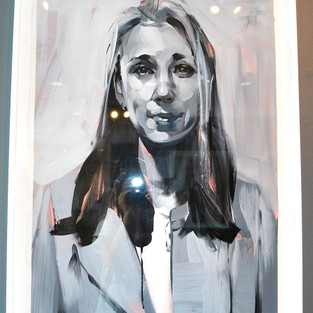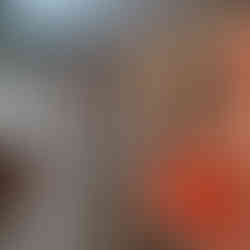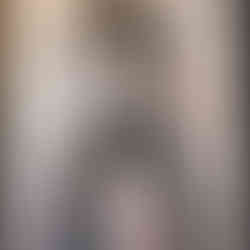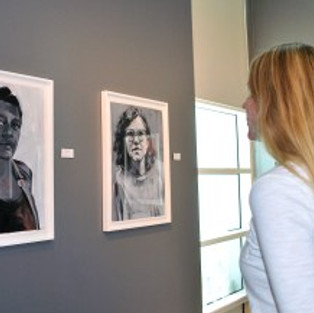
Rebecca Campbell. “You Are Here,” Kwan Fong Gallery at Cal Lutheran University. Photo Credit Cal Lutheran University.
Rebecca Campbell Represents Women Artists One Portrait at a Time
By Jennifer Susan Jones
Through April 6th
British professor of art history Simon Schama, who wrote a portraiture book last year called The Face of Britain, makes the observation that “all portraits are really — or most of them — triangular relationships.” This means that the subject is being asked to be painted a certain way, and the artist agrees, stating he or she will do a most superb job fulfilling this duty. The work, of course, must also be convincing to the third party which is the viewer: does the portrait truly look like said subject? Or is the impression one of a cheap or awkward likeness, not truly believable and not taken seriously.
Los Angeles-based painter Rebecca Campbell’s portraits succeed in all three of these realms, and in this space, painter, subject, and viewer are pleased with the finished product. For her “You Are Here” series, Campbell invited selected female subjects to her studio, where she chatted with them about their professions, their passions, and any other topic that found its way into their varied conversations. What Rebecca was looking for was the flavor of each individual – the weight of each woman’s personality – as well as the opportunity to snap photographs of the women throughout the duration of their exchange.
This was the first step in Rebecca’s journey to create an index of female artists living and working currently in the Los Angeles area, and she did so in the style she knows best: with brushes, paint, paper, and an artist’s motivation to make a difference.
To produce a great portrait, a painter should not only possess artistic talent, but he or she should also have a well-fed head, bursting with substance relating to the unique background of his or her subject. And when keen observational skill combine with deep, personal knowledge of one’s subject, the result is an accurate portrait with all the details in the right places. The whole of the subject is captured in the gaze, the posture, the signature of the head of hair, and the overall gestalt of the person being represented. Campbell is a conductive agent, receiving the signals her subjects transmit to her, then passing those sounds through her arms, hands, fingers, and brushes. The strokes compose, compile, construct the subtleties of their subject’s personalities.
For “You Are Here,” currently on view at Kwan Fong Gallery at Cal Lutheran University, Campbell painted more than a dozen women, all of which the artist felt were hard-working, dedicated, and supremely talented. Campbell also felt these women deserved to be noticed, deserved to be painted, and in placing their likenesses atop paper, stroke by well-placed stroke, these talented women would be immortalized and placed in galleries, whereby piquing the viewer’s curiosity and sparking spontaneous Google searches, all with the end result being greater public knowledge of these subjects.

Rebecca Campbell. “You Are Here,” Kwan Fong Gallery at Cal Lutheran University. Photo Credit Jennifer Susan Jones.
A likely experience had by an average viewer visiting this exhibit might look like this: viewer walks in and meanders around the paintings, noticing first that they are all the same size and constructed of the same four basic colors: salmon pink, black, white, and gray. Next, the viewer slowly realizes that all of the subjects are women, and the titles of the paintings are the names of the women featured. Curious, the viewer re-approaches one of her favorite paintings, taking note of the woman’s name on the wall tag, takes out her smartphone, and Googles said name. Within this viewing experience Campbell has achieved her goals – the women are seen and the guests attending the exhibit are educated. Goodbye lack of representation, hello attention, admiration, and name recognition.
On March 7th 2017, Campbell gave a painting demonstration and Artist’s Talk at Kwan Fong Gallery, where she spoke of process and materials. Campbell employs a variety of brushes, but she mentions that her favorite brushes -which she states is the all-time, world’s best blending tool- are the flat shaped, wooden-handled cheapies found at hardware stores. “When you are tired at the end of an eight hour painting session, and don’t feel like cleaning brushes,” Campbell states, “you can just throw these brushes away.”

Rebecca Campbell. “You Are Here,” Kwan Fong Gallery at Cal Lutheran University. Photo Credit Jennifer Susan Jones.
Campbell has made roughly three fourths of her paintings with these simple, cheap, hardware store paint brushes. According to the artist, these poor quality brushes make a less severe line and make for beautiful blending tools. Cheap brushes also hold less paint when loaded, which enables the painter to “make a big, beautiful, lyrical brush mark, but you haven’t spent forty dollars on that mark.” She also prefers a filbert for its line versatility, and favors soft bristles over stiff as she feels the softs have more flexibility.
Campbell imparted words of wisdom regarding brand and cost of paint, citing the reduction of anxiety felt when a painter allows him or herself to use materials more liberally and employing greater risk taking behaviors. “I like to keep my studio as un-precious as possible.” The artist usually uses oil paint but for this project she used a special acrylic called “Open” which has a slower dry time than traditional acrylics.
First step for Campbell is to start a line sketch directly with paint (starting with pencil is contraindicated), making very light brush marks. She also uses mid-level quality paint, Gamblin. She feels that expensive materials can lead to anxiety which can restrict an artist’s creative flow. There is a mid-point she believes, between the quality of materials one needs to make beautiful work, and the relaxed state of mind that comes when one is able to explore and create without a considerable financial investment.
Campbell starts with the pink-painted paper, then creates a rough sketch of the major features and then paints the background. She continues to dance across the portrait, making marks in grey, black, white, slowly building a face mark by mark. She recommends painting in all the major areas to capture the basic forms, and if you find yourself stuck, walking away from areas you are having trouble with. Campbell pointed out that in her portraits; some of the faces have thick marks, while others have hardly any paint on the faces at all. She states that you have to learn how to “trust open space” and release the preconceived idea that if you haven’t worked on something for a long time it isn’t real or isn’t valuable. She quoted Matisse to illustrate her point: “It’s not the amount of time it takes to make a painting that makes it valuable, it’s the amount of time that it took to prepare to be able to make that painting.”
Make lots of paintings, she says, take lots of risks, and allow your work to just be. If something looks great, accept it, and walk away. It’s like ending on a high note, or leaving after a good punch line: the best practice is to quit while you’re ahead.
“You Are Here” is on view at Kwan Fong Gallery at Cal Lutheran University until April 6th, 2017.
#losangeles #california #femaleartist #losangelesartist #art #onlineartmagazine #losangelesart #contemporaryart #portraiture #southerncalifornia #LosAngelesArtists #portrait #artgallery #gallery #contemporaryportraiture #artandcake #LALouver #artexhibition #femaleartists #ArtandCakeLA #fineart #KwanFongGallery #artists #artist #artreview #YouAreHere #artexhibit #artmagazine #RebeccaCampbell #CalLutheranUniversity #ArtandCulture #jennifersusanjones




















































